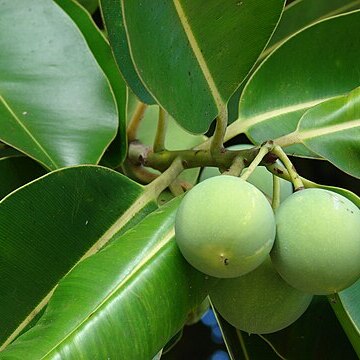Trees or shrubs, with clear [or milky or yellow] latex. Apical buds rarely abortive; buds lacking (or with) scales. Leaves opposite, petiolate [or rarely sessile], leathery, usually glabrous; secondary veins many, almost perpendicular to midvein, ± prominent above; tertiary venation absent; translucent glandular canals present between veins. Inflorescence cymose or thyrsiform, terminal or axillary. Flowers bisexual [or rarely unisexual]. Sepals and petals together 4-12 (usually 4 + 4 in Chinese species), 2-or 3-whorled, not always differentiated, outer (sepals) decussate, inner (petals) imbricate. Stamens many, not obviously fascicled; filaments scarcely united or all free, slender; anthers erect, basifixed; fasciclodes absent. Ovary 1-loculed, glabrous [tomentose], with a single erect ovule; style elongate, slender; stigma often peltate. Drupelike berry with thin exocarp ("skin"), thin fleshy mesocarp and thin endocarp sometimes adherent to seed. Seed 1, large, with thin [or thick] testa ("stone"); embryo with broad fleshy cotyledons.
Trees or rarely shrubs, secreting a milky yellow or clear latex; bark of young trees with characteristic diamond-or boat-shaped fissures. Leaves opposite, petiolate or rarely ± sessile, entire, usually coriaceous, with very numerous and closely placed fine parallel lateral nerves alternating with ± translucent glandular canals. Flowers terminal or axillary, in few–many-flowered racemes or panicle-like cymes or rarely reduced to 1–3, hermaphrodite. Sepals 4, free, the inner pair sometimes ± petaloid. Petals 2 or 4–8 or sometimes absent, white, imbricate, not always distinguishable from the inner sepals. Stamens numerous, usually arranged in 4 bundles opposite the petals or sometimes ± free; filaments slender and ± flexuous; anthers ovate to linear-oblong. Ovary 1-locular, with solitary erect ovule; style simple, slender, often flexuous; stigma peltate. Fruit a drupe, with brittle or thick pericarp and 1 large seed.
Trees [shrubs], hairy at least on buds, with stilt or loop roots. Stems ± flattened and angled when young. Leaves: petiole concave, without adaxial protuberance; blade coriaceous, venation close, apparently unbranched, parallel, uniting to form marginal or submarginal vein and alternating with and usually more prominent than latex canals, without tertiary venation visible between lateral veins. Inflorescences racemiform; peduncle and rachis usually present; bracts usually deciduous, small. Flowers bisexual; sepals deciduous, 4, distinct, in decussate pairs, outer 1–2 pairs rarely much different from rest; stamens obscurely 4-fascicled; style slender, ca. 4 times as long as ovary. Fruits drupaceous; pericarp firm or fleshy, smooth when fresh. Seeds 1. x = 16.
Trees, hermaphrodite; latex present usually coloured. Twigs ±flattened. Leaves petiolate; lamina ±coriaceous, with numerous parallel secondary veins, reticulate venation absent. Inflorescences terminal or axillary, solitary, cymose, pseudoracemose or pseudopaniculate, with 1 to many flowers; bracts mostly deciduous. Flowers pedicellate, with perianth of tepals 4–8 (–13); stamens many, 2 or several seriate, slightly connate at base, anthers basifixed, oblong, dehiscing longitudinally; ovary subglobose or ovoid, unilocular, ovule solitary, style single, terete; stigma often peltate. Fruit a drupe; exocarp thin usually brittle; mesocarp well developed, fleshy to fibrous; endocarp bony or crustaceous, 1-seeded.
Leaves opposite, almost always petiolate, entire, often coriaceous, with lateral nerves numerous, slender, close together and parallel (usually nearly at right angles to the midrib), alternating with ± translucent glandular canals.
Androecium of 4 antipetalous stamen-fascicles each of numerous stamens, or sometimes with stamens apparently free; filaments slender and sometimes flexuous; anthers ovate to linear-oblong; fasciclodes absent.
Flowers terminal or axillary, in few-to many-flowered racemes or paniculate cymes or rarely reduced to 1–3, bisexual.
Petals 4–8 (sometimes absent), white, imbricate, not always distinguishable from the inner sepals.
Ovary 1-locular, with a single erect ovule; style simple, slender, often flexuous; stigma peltate.
Trees or rarely shrubs secreting a milky or yellow or clear latex.
Sepals 4, decussate, free, the inner pair sometimes ± petaloid.
Fruit a 1-seeded drupe with crustaceous pericarp.
Seeds large.

